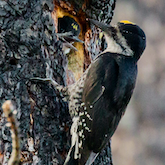At IBP, we not only do research to support more effective conservation, we also train the next generation of conservation scientists. Joanna Wu, a biologist and GIS analyst with the National Audubon Society, is a shining example of that effort.
One of Joanna's first jobs when she graduated from the University of California at Berkeley was working on as a point count technician for IBP in the summer of 2010.

Joanna Wu back in her Black-backed Woodpecker counting days.
It was such a good experience that she did it again. Joanna worked as an IBP point count technician for a couple of field seasons and then decided to get her master's degree at the University of Hawaii at Hilo studying the movement patterns and seed dispersal by a native frugivore, the`Ōma`o, and a non-native frugivore, the Japanese White-eye. But she kept her eye on IBP.
"I really liked how IBP operated and how friendly everyone was. So I had kept in touch with Rodney and I said, 'Hey, I'm getting my masters. When I'm done, I'm going to move back to the Bay Area, and I'm going to be looking for a job'... So when I did graduate, he had some funding to work on a Great Gray Owl project."
Joanna returned to IBP as a staff biologist in 2013 and worked on the owls, resulting in three published scientific papers examining Great Gray Owl nesting biology and response to fire. She also worked on reports for the U.S. Forest Service on Black-backed Woodpeckers, Spotted Owls and Northern Goshawks. Finally, Joanna was the first author on the Great Gray Owl conservation strategy that IBP produced for the state of California in 2016.
Joanna says her time as a staff biologist at IBP gave her great experiences that help her in her current position, such as data analysis with R software and partnership building.
"As a recently graduated master's student, I hadn't built a lot of relationships with organizational partners, but for the Great Gray Owl work, I really had to work with all the Great Gray Owl experts across California."
These days Joanna is definitely putting those partnership building skills to work for the National Audubon Society where she primarily focuses on climate change. In 2018, she published a paper in the journal PLoS One examining how bird populations in U.S. National Parks are expected to respond to climate change. And she is currently working on the Audubon's much anticipated 2019 Birds and Climate Change Report, which is set to be released in the fall.
Thank you, Joanna, for all your hard work on behalf of birds and conservation! Your friends at IBP are very proud of you.






